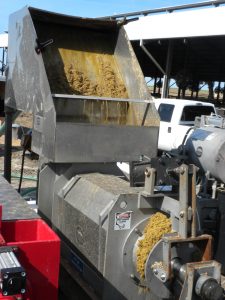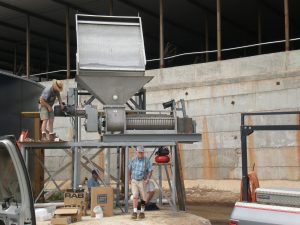We cannot name another industrial product that goes by so many different names. Static screens are known as sidehill screens in the pulp and paper industry. The same devises are commonly referred to as gravity screens, Hydrasieves, DSM’s, and Hydradensers. Sometimes they are called slope, catenary, parabolic or arc screens. (“Catenary”, favored by the late Dr. Ashley Vincent, is the shape that a chain takes when it is hung from two points, although the screens are generally rolled only to a simple radius.) In the mining industry they may call them sieve bends.
The device we are referring to consists of liquid reservoir at the top, a weir over which liquid flows, and a sloped screen which allows filtered liquid to flow through while suspended solids are being separated. The solids, known as tailings, fall off the lower end of the screen.
Vincent Corporation has an interest in static screens because they serve two key purposes: They can be used to thicken a dilute flow ahead of our screw presses. And they also can be used to filter press liquor from a screw press so that the fiber that is separated can be re-admitted to the press.
For example, if a client has a dilute flow with only 0.5 to 1% solids, it may take a large press to handle the volume of liquid involved. If instead the client thickens the flow to 4% to 8% solids by running it across a static screen, a press one or two sizes smaller than otherwise required will be able to handle the job. The combination of the static screen along with the smaller press will cost less than the single larger press.
Vincent can point to a number of successful paper mill jobs from the 1990’s where we supplied static screens which were mounted over the inlets of our presses. The screens were an old Vincent design that had unique premium features. The screen surface was made of woven wavy wedgewire which sometimes performed better. The screen surface was curved, which makes the screen more effective than a flat surface screen. In addition, these screens had features which are no longer available. This included adjustable weir boxes and jacking bolts for adjusting the inclination angle of the screens. The costs of many of these features were not justified by improved performance, so they have been discontinued.
Static screens are sold in standard widths: 18″, 2’, 3’, 4’, 5’, and 6’. We generally think of them as having capacities of 50 to 150 gpm per foot of width. This figure works on press liquor flows found in juice processing plants. In paper mill applications, figures of 300 to 600 gpm per foot are used with certain “high freeness” flows.
Another option available in static screens is the slot width of the wedgewire. The most common specifications are 0.020″ and 0.030″. The finer the slot, the finer the filtration. This is offset by capacity reduction and a propensity to blind.
When the solids in the liquid flow have a tendency to blind the screen, a spray bar accessory can be supplied. The spray bar is a network of pipes and nozzles. It is used to periodically spray the face of the screen with water. Sometimes a timer is used to automate the process. Generally the front of the screen is cleaned with the spray system, although we have seen cases where we mounted the sprays on the back side of the screen.
2010 Addendum
Static screens generally have very long surfaces in order to produce the driest possible surfaces. Driven by a need to lower costs, Vincent has developed a line of sidehills, the Series M, where the surfaces are only 30″ long. There is usually a stream of liquid, along with the solids, coming off the ends of these screens. However, since the flow is going into a screw press, the press removes this excess moisture.
As seen in the photos below, these Series M sidehills bolt directly onto the inlet of the screw press, while the larger screens require a transition chute.


VDS-30-M ON KP-10 PRESS VDS-72 OVER KP-16 PRESS
Vincent keeps a range of sidehill screens available in the rental fleet.
Issue 60R
